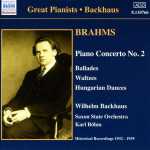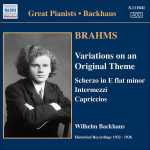
Composer: Johannes Brahms
Performer: Wilhelm Backhaus
Orchestra: BBC Symphony Orchestra
Conductor: Adrian Boult
Format: FLAC (tracks)
Label: Naxos
Catalogue: 8110699
Release: 2003
Size: 155 MB
Recovery: +3%
Scan: yes
Piano Concerto No. 1 in D minor, Op. 15
01. I. Maestoso
02. II. Adagio
03. III. Allegro non troppo
28 Variations on a Theme by Paganini, Op. 35
04. Theme
05. Book I: Variation 1
06. Book I: Variation 2
07. Book I: Variation 3
08. Book I: Variation 4
09. Book I: Variation 5
10. Book I: Variation 6
11. Book I: Variation 7
12. Book I: Variation 8
13. Book I: Variation 9
14. Book I: Variation 10
15. Book I: Variation 11
16. Book I: Variation 12
17. Book I: Variation 13
18. Book I: Variation 14
19. Book II: Variation 1
20. Book II: Variation 2
21. Book II: Variation 3
22. Book II: Variation 4
23. Book II: Variation 5
24. Book II: Variation 6
25. Book II: Variation 7
26. Book II: Variation 8
27. Book II: Variation 9
28. Book II: Variation 10
29. Book II: Variation 11
30. Book II: Variation 12
31. Book II: Variation 13
32. Book II: Variation 14
2 Rhapsodies, op. 79
33. No. 1 in B Minor
34. No. 2 in G Minor
Mark Obert-Thorn has performed an inestimable service for Naxos and fans of historical recordings by restoring the great performances of the past with the most advanced technology. The recordings — taken from the cleanest 78 rpm pressings available — are remarkable, not only for the depth of sound and the precise editing of sides, but also because musical values are preserved without artificial effects or misguided attempts at noise reduction. In Wilhelm Backhaus’ 1932 recording of the Brahms Piano Concerto No. 1, the piano’s central placement is apparent without audio enhancement, and the performer is clearly heard at all dynamic levels. Although the orchestra’s sound is a little fuzzy at times, with strings too dominant in the Allegro’s fortissimo passages, the winds are distinct in the Adagio. A sense of Adrian Boult’s blending comes through in the Allegro non troppo despite the slight sonic overload in the tutti sections. In the solo works, Backhaus is heard to better advantage and attention may be turned to his interpretations. The Variations on a Theme by Paganini, recorded in 1929, is masterfully executed, incisive, and dramatic, yet classically shaped and relatively free of rubato. The Rhapsodies (2) are even more focused and resonant, and Backhaus throws himself with full force into these passionate pieces.



